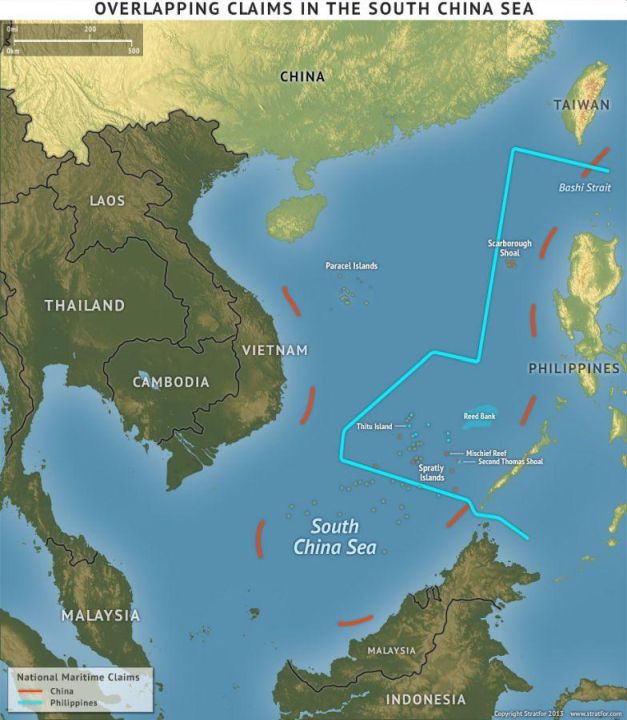By Eric Vandenbroeck and co-workers
The South China Sea Dispute Redux
Last weekend, the South
China Sea was unprecedentedly busy with military activities. For the very
first time, the Chinese navy deployed three aircraft carriers at the same time
and in the same place. The United States, Australia, Japan, and the
Philippines, meanwhile, were joined by New Zealand for the first time for naval
drills in the Philippines' exclusive economic zone. Indeed, there has been a
considerable uptick in China's military exercises and associated activities
over the past few months – sometimes on its own, sometimes in concert with
Russia.
Though the
demonstration of newly developed assets isn’t unheard of, China typically shows
them off by staging peaceful air or naval performances. But that is starting to
change. In late August, for example, a Chinese Y-9 surveillance plane violated
Japanese airspace for the very first time, even as Chinese ships encroached on
the disputed Senkaku/Diaoyu islands. Also over the summer, record-breaking
numbers of Chinese naval ships and aircraft were reported near Taiwan. China’s
increasingly routine incursions into the island’s air defense identification
zone have gotten closer to the island itself. Violent naval collisions with the
Philippines near the disputed maritime zones in the South China Sea have also
become more frequent, causing both nations to maintain a bigger presence in the
area.
China’s demonstration
of strength is meant to remind its neighbors that it is still a force in the
region worth allying with. This has become all the more urgent for Beijing, as
the U.S.-led Pacific alliance increases defense-related cooperation.
But there is another
reason Beijing has chosen now, of all times, to flex its military muscle:
money. Though trade talks between the U.S. and China continue apace, the two
have been unable to reach an agreement. U.S. investors are leading the charge
in a steady exodus of foreign capital from China. Moreover, a new round of U.S.
tariffs on $18 billion worth of Chinese goods including electric vehicles, EV
batteries and solar panels just came into effect, pushing China even further
away from what it had hoped to achieve in the discussions. (Separate EV tariffs
levied by the European Union may start in late October.) As a result, Beijing
has begun to abandon the hope that it could prop up its economy with Western
foreign direct investment. Its military exercises, then, are meant to project
stability and power while Beijing solves its economic problems on its own.
It’s no coincidence
that as these maritime incidents took place, Beijing was mulling a decision
that would fundamentally change the way it handled its economy: Should stimulus
measures be introduced slowly and their effects tested gradually, or should an
aggressive, coordinated package be introduced all at once? Only a month ago it
seemed as though most Chinese economists and Politburo members agreed that
starting small was the way to go. After all, for years it has been the
government’s preferred method of operating. But last Tuesday, when People’s
Bank of China Gov. Pan Gongsheng introduced a new
package of large-scale support measures, including cuts to the mortgage rate
for existing loans and its reserve requirement ratio, as well as new tools to
prop up the stock market. These measures were followed by an unexpected
announcement that the government planned to give one-time cash handouts to
people living in poverty – a welfare scheme that not even a year ago was deemed
ineffective.
Put simply, this
means that Beijing has determined that steadily declining housing prices,
defaulting property developers, weak consumer confidence, dependence on foreign
markets for its manufacturing surplus and high levels of youth unemployment
cannot be slowly or gently nudged away. It means that Beijing realizes it must
count on itself, not Western FDI, to solve its economic problems. And it means
it no longer has to “behave” in the South China Sea.
Understandably,
China’s military activity has put the U.S. and its Pacific allies on high
alert. Its on-again-off-again coordination with Russia has only added to their
concerns. During Ocean 2024, a joint naval exercise in the Pacific and Arctic
oceans, as well as the Mediterranean, Caspian and Baltic seas, Russian aircraft
were tracked entering the Alaska Air Defense Identification Zone, bringing home
the risk that a Sino-Russian alliance poses.
To some degree, an alliance makes sense.
Russia is in the middle of a prolonged military campaign that has resulted in
international sanctions against it, and China needs to find a way to turn its
economy around. Both want to direct global attention from their weaknesses to
their strengths and, more important, maintain their regional influence. An
important strength for China and Russia is their respective militaries, both of
which have been modernized in a relatively short amount of time. It’s little wonder,
then, that their cooperation in technology, especially military technology, has
been steady and intense. With joint military demonstrations, both countries can
show that they can maintain their status and that they are capable of starting
a fight if they want to.

Yet China’s military capabilities have some serious
flaws. According to a recent U.S. report, a Chinese nuclear-powered attack
submarine sank in its dock this summer while under construction – a major
setback for the navy and an indication that though the Chinese military program
might be booming, it may be sacrificing quality for speed.
Even so, China’s
defense-based relationship with Russia looks likely to continue, and as it
does, it risks conflict even with its regional allies. Earlier this week,
Vietnam criticized an attack by Chinese law enforcement forces on Vietnamese
fishermen near a disputed island, while Malaysia has increased drilling
operations in a disputed area in the South China Sea despite Beijing’s newfound
military posture. These incidents show that China may achieve the opposite of
what it wants: to be a feared player in the Asia-Pacific. Its economic problems
and the shortfalls of its military don’t do it any favors.
For updates click hompage here